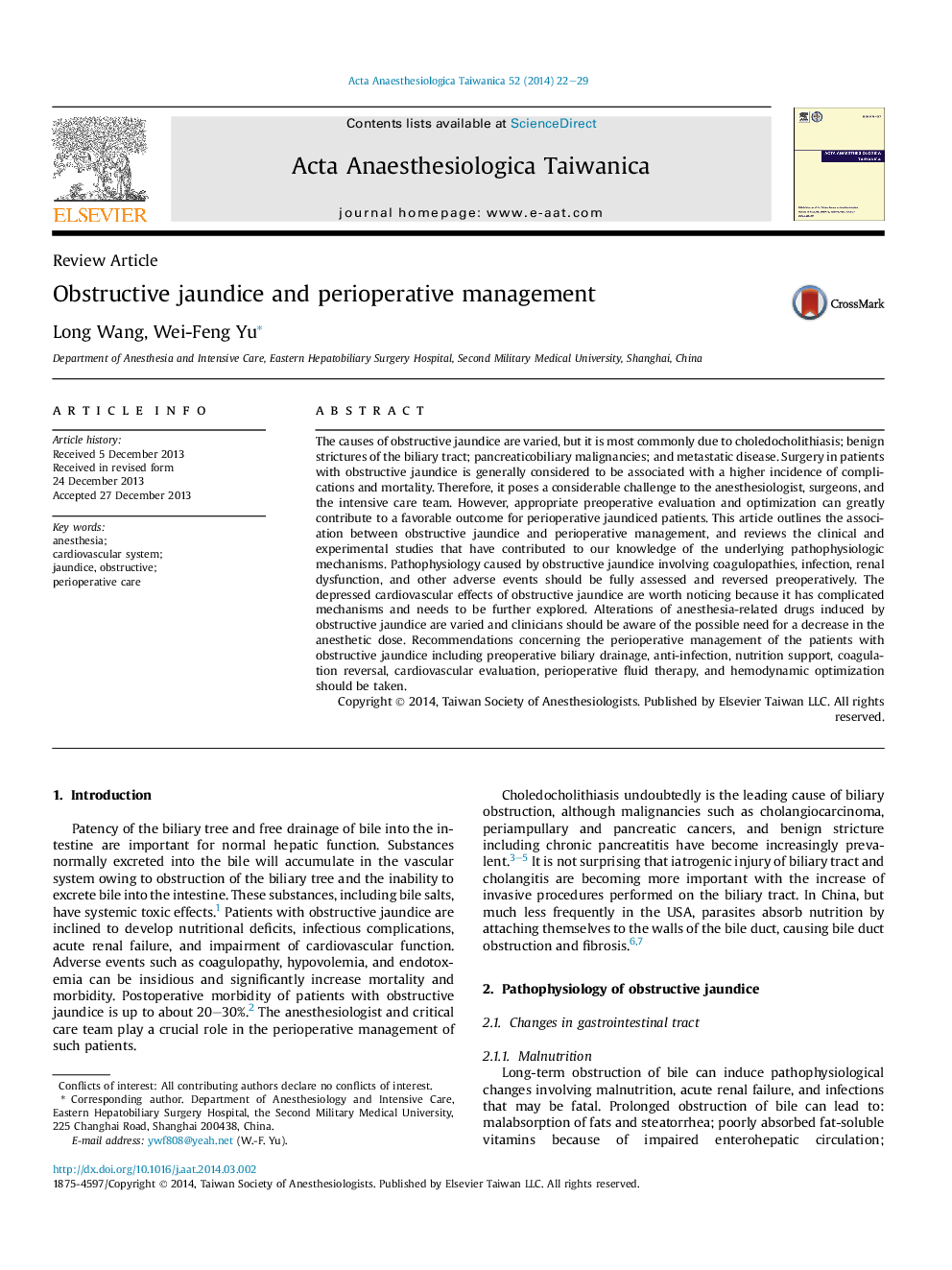| کد مقاله | کد نشریه | سال انتشار | مقاله انگلیسی | نسخه تمام متن |
|---|---|---|---|---|
| 2741444 | 1148530 | 2014 | 8 صفحه PDF | دانلود رایگان |
عنوان انگلیسی مقاله ISI
Obstructive jaundice and perioperative management
ترجمه فارسی عنوان
زردی انسدادی و مدیریت حین عمل
دانلود مقاله + سفارش ترجمه
دانلود مقاله ISI انگلیسی
رایگان برای ایرانیان
کلمات کلیدی
بیهوشی سیستم قلبی عروقی، زردی، انسداد مراقبت دوره ای،
ترجمه چکیده
علل زردی انسدادی متغیر هستند، اما اغلب به علت درد قفسه سینه است. رگ های خوش خیم دستگاه صفراوی؛ بدخیمی های پانکراس بیوتیار؛ و بیماری متاستاتیک جراحی در بیماران مبتلا به زردی انسدادی، به طور کلی در نظر گرفته شده است که با بروز بیشتر عوارض و مرگ و میر همراه است. بنابراین، آن را به یک متخصص بیهوشی، جراحان و تیم مراقبت های فوری معضل بزرگی می زند. با این حال، ارزیابی و بهینه سازی قبل از عمل مناسب می تواند تا حد زیادی به نتیجه مطلوب برای بیماران مبتلا به زردی مبتلا شود. این مقاله رابطه بین زردی انسدادی و مدیریت درمانی را تشریح می کند و مطالعات بالینی و تجربی را که به دانش ما از مکانیزم های پاتوفیزیولوژیک پایه کمک می کند، بررسی می کند. پاتوفیزیولوژی ناشی از زردی انسدادی شامل کواگولوپاتی، عفونت، اختلال عملکرد کلیوی و سایر عوارض جانبی باید به طور کامل ارزیابی شود و قبل از عمل برگشت یابد. اثرات قلب و عروق افسردگی زردی انسدادی اهمیت دارد، زیرا مکانیسم پیچیده ای دارد و باید بیشتر مورد بررسی قرار گیرد. تغییرات داروهای مرتبط با بیهوشی ناشی از زردی انسدادی متفاوت است و پزشکان باید از احتمال احتمالی کاهش دوز بیهوشی آگاه باشند. توصیه های مربوط به مدیریت درمانی از بیماران مبتلا به زردی انسدادی شامل تخلیه صفراوی قبل از عمل، ضد عفونت، حمایت از تغذیه، انقباض انعقاد، ارزیابی قلب و عروق، درمان مایع درمانی و بهینه سازی همودینامیکی است.
موضوعات مرتبط
علوم پزشکی و سلامت
پزشکی و دندانپزشکی
بیهوشی و پزشکی درد
چکیده انگلیسی
The causes of obstructive jaundice are varied, but it is most commonly due to choledocholithiasis; benign strictures of the biliary tract; pancreaticobiliary malignancies; and metastatic disease. Surgery in patients with obstructive jaundice is generally considered to be associated with a higher incidence of complications and mortality. Therefore, it poses a considerable challenge to the anesthesiologist, surgeons, and the intensive care team. However, appropriate preoperative evaluation and optimization can greatly contribute to a favorable outcome for perioperative jaundiced patients. This article outlines the association between obstructive jaundice and perioperative management, and reviews the clinical and experimental studies that have contributed to our knowledge of the underlying pathophysiologic mechanisms. Pathophysiology caused by obstructive jaundice involving coagulopathies, infection, renal dysfunction, and other adverse events should be fully assessed and reversed preoperatively. The depressed cardiovascular effects of obstructive jaundice are worth noticing because it has complicated mechanisms and needs to be further explored. Alterations of anesthesia-related drugs induced by obstructive jaundice are varied and clinicians should be aware of the possible need for a decrease in the anesthetic dose. Recommendations concerning the perioperative management of the patients with obstructive jaundice including preoperative biliary drainage, anti-infection, nutrition support, coagulation reversal, cardiovascular evaluation, perioperative fluid therapy, and hemodynamic optimization should be taken.
ناشر
Database: Elsevier - ScienceDirect (ساینس دایرکت)
Journal: Acta Anaesthesiologica Taiwanica - Volume 52, Issue 1, March 2014, Pages 22-29
Journal: Acta Anaesthesiologica Taiwanica - Volume 52, Issue 1, March 2014, Pages 22-29
نویسندگان
Long Wang, Wei-Feng Yu,
